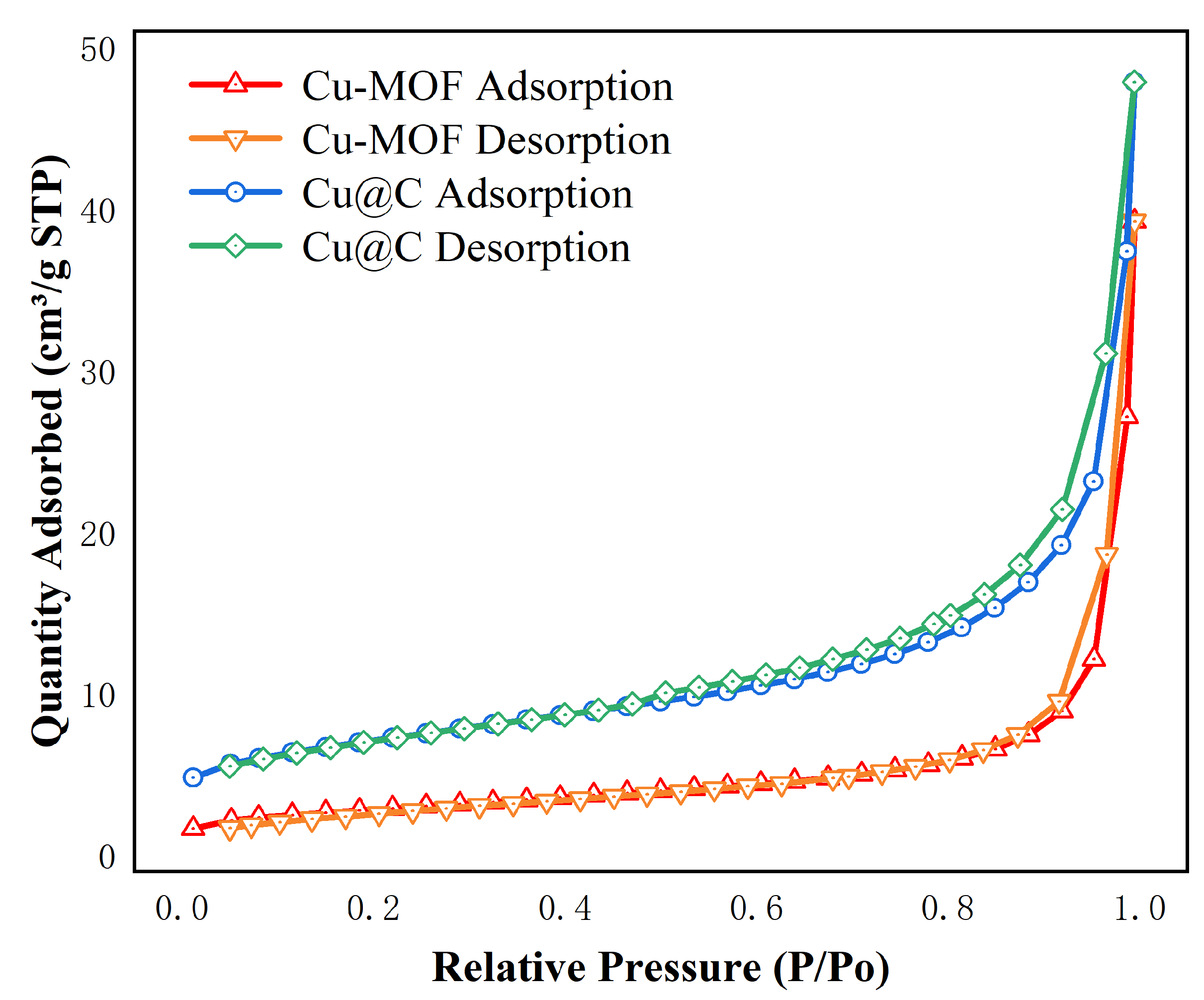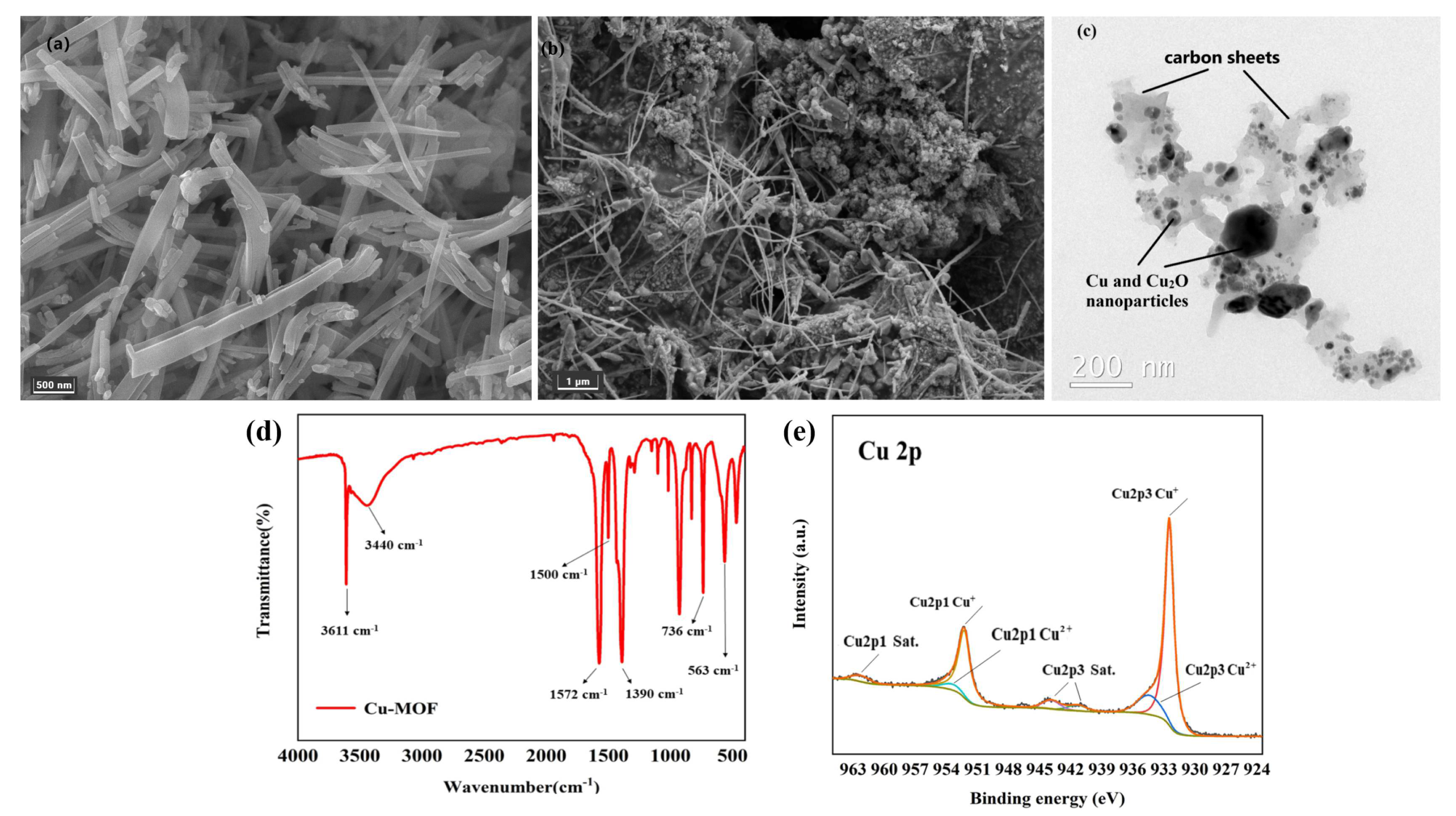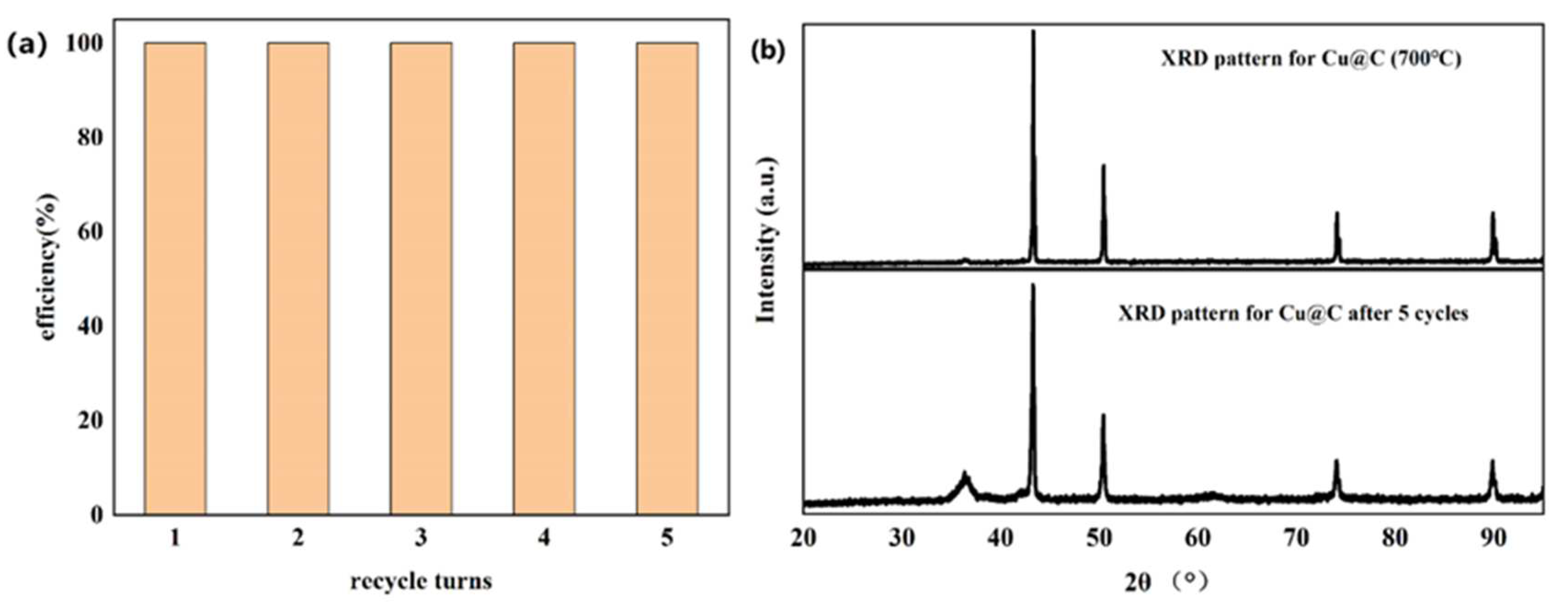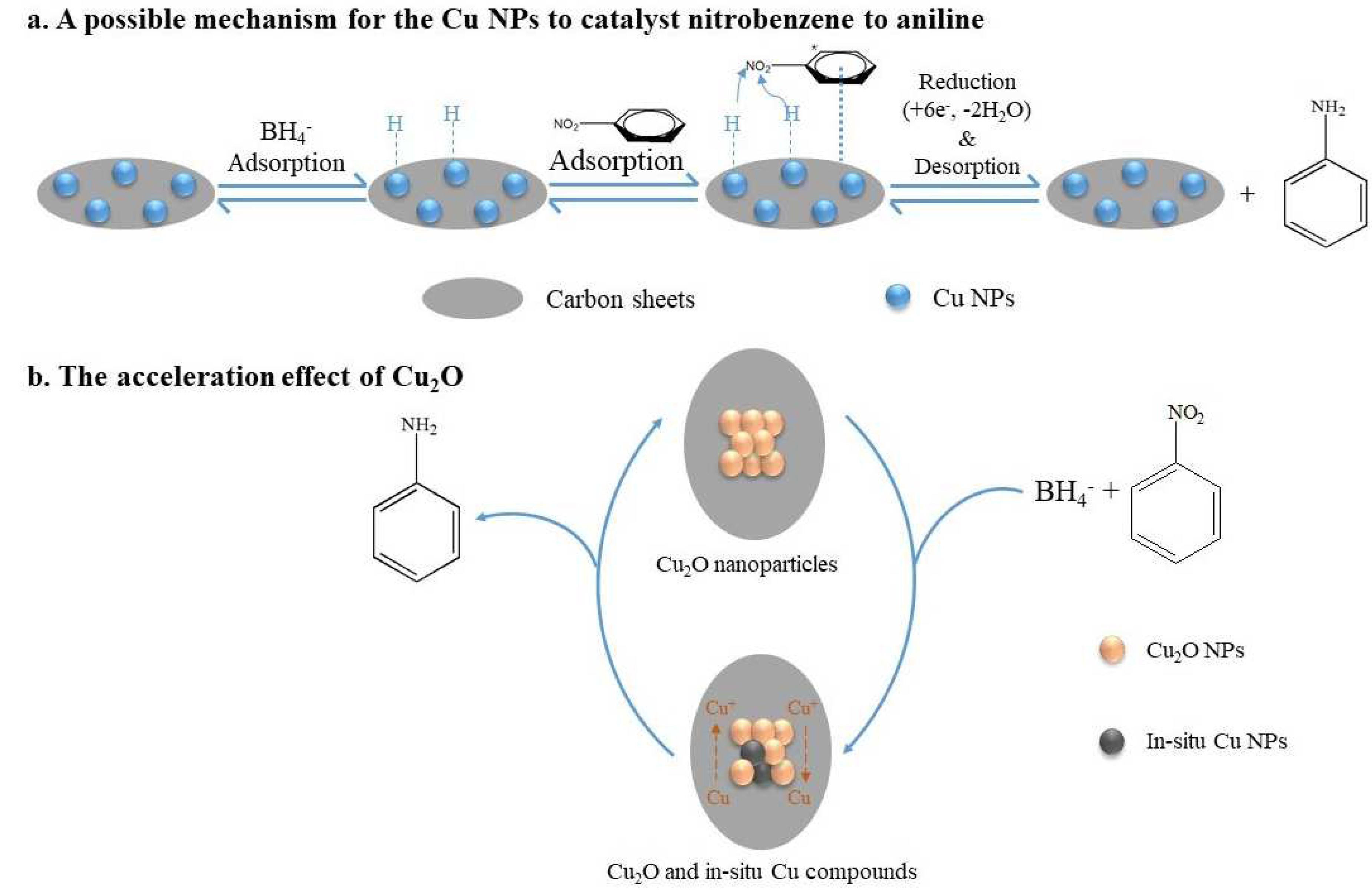Highly Efficient Catalytic Reduction of Nitrobenzene Using Cu@C Based on a Novel Cu–MOF Precursor
Abstract
1. Introduction
2. Results and Discussion
2.1. Materials Synthesis and Characterizations
2.2. Catalytic Reduction of Nitrobenzene
2.3. Catalytic Mechanism
3. Materials and Methods
3.1. Synthesis of Cu–MOF and Cu@C
3.2. Characterization Techniques
3.3. Catalytic Reduction of Nitrobenzene
3.4. Stability and Recyclability of the Catalyst
4. Conclusions
Supplementary Materials
Author Contributions
Funding
Data Availability Statement
Acknowledgments
Conflicts of Interest
References
- Ebadati, E.; Aghabarari, B.; Bagheri, M.; Khanlarkhani, A.; Martinez Huerta, M.V. Palladium nanoparticles supported on silicate-based nanohybrid material: Highly active and eco-friendly catalyst for reduction of nitrobenzene at ambient conditions. Inorg. Nano-Met. Chem. 2020, 51, 569–578. [Google Scholar] [CrossRef]
- Chen, W.S.; Liu, Y.C. Photocatalytic degradation of nitrobenzene in wastewater by persulfate integrated with Ag/Pb3O4 semiconductor under visible light irradiation. Heliyon 2021, 7, e06984. [Google Scholar] [CrossRef] [PubMed]
- Nawaz, M.I.; Yi, C.W.; Ni, L.X.; Zhao, H.; Wang, H.J.; Yi, R.J.; Yin, L.L.; Aleem, M.; Zaman, M. Removal of nitrobenzene from wastewater by vertical flow constructed wetland and optimizing substrate composition using Hydrus-1D: Optimizing substrate composition of vertical flow constructed wetland for removing nitrobenzene from wastewater. Int. J. Environ. Sci. Technol. 2019, 16, 8005–8014. [Google Scholar] [CrossRef]
- Wu, J.H.; Zhang, F. Rapid aerobic visible-light-driven photo-reduction of nitrobenzene. Sci. Total Environ. 2020, 710, 136322. [Google Scholar] [CrossRef]
- Scarborough, T.D.; McAcy, C.J.; Beck, J.; Uiterwaal, C. Comparison of ultrafast intense-field photodynamics in aniline and nitrobenzene: Stability under amino and nitro substitution. Phys. Chem. Chem. Phys. 2019, 21, 6553–6558. [Google Scholar] [CrossRef]
- Kainthla, I.; Gurram, V.R.B.; Bhanushali, J.T.; Kamaraju, S.R.R.; Keri, R.S.; Gosavi, S.W.; Jadhav, A.H.; Nagaraja, B.M. In Situ Generation of Cu-0 Supported on TiO2 Aerogel as a Catalyst for the Vapour Phase Hydrogenation of Nitrobenzene to Aniline. Catal. Lett. 2018, 148, 2891–2900. [Google Scholar] [CrossRef]
- Zhang, X.; Wang, Z.; Yang, M.; Ma, W. Pilot study of treatment on nitrobenzene wastewater. Ind. Water Treat. 2021, 41, 115–118. [Google Scholar]
- Paul, B.; Vadivel, S.; Yadav, N.; Dhar, S.S. Room temperature catalytic reduction of nitrobenzene to azoxybenzene over one pot synthesised reduced graphene oxide decorated with Ag/ZnO nanocomposite. Catal. Commun. 2019, 124, 71–75. [Google Scholar] [CrossRef]
- Qu, Y.M.; Chen, T. Fullerene derivative supported Ni for hydrogenation of nitrobenzene: Effect of functional group of fullerene derivative. Chem. Eng. J. 2020, 382, 122911. [Google Scholar] [CrossRef]
- Hajdu, V.; Muranszky, G.; Nagy, M.; Kopcsik, E.; Kristaly, F.; Fiser, B.; Viskolcz, B.; Vanyorek, L. Development of High-Efficiency, Magnetically Separable Palladium-Decorated Manganese-Ferrite Catalyst for Nitrobenzene Hydrogenation. Int. J. Mol. Sci. 2022, 23, 6535. [Google Scholar] [CrossRef]
- Neeli, C.K.P.; Puthiaraj, P.; Lee, Y.R.; Chung, Y.M.; Baeck, S.H.; Ahn, W.S. Transfer hydrogenation of nitrobenzene to aniline in water using Pd nanoparticles immobilized on amine-functionalized UiO-66. Catal. Today 2018, 303, 227–234. [Google Scholar] [CrossRef]
- Li, J.R.; Li, X.H.; Ding, Y.; Wu, P. Pt nanoparticles entrapped in ordered mesoporous carbons: An efficient catalyst for the liquid-phase hydrogenation of nitrobenzene and its derivatives. Chin. J. Catal. 2015, 36, 1995–2003. [Google Scholar] [CrossRef]
- Jiang, Y.X.; Li, X.L.; Qin, Z.Z.; Ji, H.B. Preparation of Ni/bentonite catalyst and its applications in the catalytic hydrogenation of nitrobenzene to aniline. Chin. J. Chem. Eng. 2016, 24, 1195–1200. [Google Scholar] [CrossRef]
- Wang, H.H.; Zhang, W.; Liu, Y.Q.; Pu, M.; Lei, M. First-Principles Study on the Mechanism of Nitrobenzene Reduction to Aniline Catalyzed by a N-Doped Carbon-Supported Cobalt Single-Atom Catalyst. J. Phys. Chem. C 2021, 125, 19171–19182. [Google Scholar] [CrossRef]
- Khosravi, F.; Gholinejad, M.; Sansano, J.M.; Luque, R. Bimetallic Fe-Cu metal organic frameworks for room temperature catalysis. Appl. Organomet. Chem. 2022, 36, e6749. [Google Scholar] [CrossRef]
- Darawsheh, M.D.; Mazario, J.; Lopes, C.W.; Gimenez-Marques, M.; Domine, M.E.; Meira, D.M.; Martinez, J.; Minguez Espallargas, G.; Ona-Burgos, P. MOF-Mediated Synthesis of Supported Fe-Doped Pd Nanoparticles under Mild Conditions for Magnetically Recoverable Catalysis*. Chemistry 2020, 26, 13659–13667. [Google Scholar] [CrossRef]
- Wang, J.H.; Kim, J.; Bu, J.; Kim, D.; Kim, S.Y.; Nam, K.T.; Varma, R.S.; Jang, H.W.; Luque, R.; Shokouhimehr, M. MOF-derived NiFe2O4 nanoparticles on molybdenum disulfide: Magnetically reusable nanocatalyst for the reduction of nitroaromatics in aqueous media. J. Ind. Eng. Chem. 2022, 107, 428–435. [Google Scholar] [CrossRef]
- Wu, C.; Zhu, C.; Liu, K.; Yang, S.; Sun, Y.; Zhu, K.; Cao, Y.; Zhang, S.; Zhuo, S.; Zhang, M.; et al. Nano-pyramid-type Co-ZnO/NC for hydrogen transfer cascade reaction between alcohols and nitrobenzene. Appl. Catal. B Environ. 2022, 300, 120288. [Google Scholar] [CrossRef]
- Hu, A.; Lu, X.H.; Cai, D.M.; Pan, H.J.; Jing, R.; Xia, Q.H.; Zhou, D.; Xia, Y.D. Selective hydrogenation of nitroarenes over MOF-derived Co@CN catalysts at mild conditions. Mol. Catal. 2019, 472, 27–36. [Google Scholar] [CrossRef]
- Li, J.Y.; Wang, B.W.; Qin, Y.T.; Tao, Q.; Chen, L.G. MOF-derived Ni@NC catalyst: Synthesis, characterization, and application in one-pot hydrogenation and reductive amination. Catal. Sci. Technol. 2019, 9, 3726–3734. [Google Scholar] [CrossRef]
- Guo, C.Y.; Liang, C.H.; Qin, X.P.; Gu, Y.J.; Gao, P.; Shao, M.H.; Wong, W.T. Zeolitic Imidazolate Framework Cores Decorated with Pd Nanoparticles and Coated Further with Metal-Organic Framework Shells (ZIF-8@Pd@MOF-74) as Nanocatalysts for Chemoselective Hydrogenation Reactions. Acs Appl. Nano Mater. 2020, 3, 7242–7251. [Google Scholar] [CrossRef]
- Wu, W.; Zhang, W.; Long, Y.; Qin, J.H.; Ma, J.T. MOF-derived Fe-N-C with interconnected mesoporous structure for halonitrobenzenes hydrogenation: Role of dicyandiamide on the growth of active sites and pore structure. Micropor. Mesopor. Mat. 2021, 328, 111472. [Google Scholar] [CrossRef]
- Li, X.W.; She, W.; Wang, J.; Li, W.Z.; Li, G.M. A highly efficient LaOCl supported Fe-Fe3C-based catalyst for hydrogenation of nitroarenes fabricated by coordination-assisted pyrolysis. Catal. Sci. Technol. 2021, 11, 4627–4635. [Google Scholar] [CrossRef]
- Ye, G.; Luo, P.; Zhao, Y.; Qiu, G.; Hu, Y.; Preis, S.; Wei, C. Three-dimensional Co/Ni bimetallic organic frameworks for high-efficient catalytic ozonation of atrazine: Mechanism, effect parameters, and degradation pathways analysis. Chemosphere 2020, 253, 126767. [Google Scholar] [CrossRef]
- Yusran, Y.; Xu, D.; Fang, Q.R.; Zhang, D.L.; Qiu, S.L. MOF-derived Co@N-C nanocatalyst for catalytic reduction of 4-nitrophenol to 4-aminophenol. Micropor. Mesopor. Mat. 2017, 241, 346–354. [Google Scholar] [CrossRef]
- Su, Y.P.; Li, Z.Y.; Zhou, H.J.; Kang, S.H.; Zhang, Y.X.; Yu, C.Z.; Wang, G.Z. Ni/carbon aerogels derived from water induced self-assembly of Ni-MOF for adsorption and catalytic conversion of oily wastewater. Chem. Eng. J. 2020, 402, 126205. [Google Scholar] [CrossRef]
- Sampaio, S.; Viana, J.C. Optimisation of the green synthesis of Cu/Cu2O particles for maximum yield production and reduced oxidation for electronic applications. Mater. Sci. Eng. B-Adv. 2021, 263, 114807. [Google Scholar] [CrossRef]
- Lam, N.H.; Le, N.; Kim, E.S.; Tamboli, M.S.; Tamboli, A.M.; Truong, N.T.N.; Jung, J.H. Powder X-ray diffraction analysis of Cu/Cu2O nanocomposites synthesized by colloidal solution method. Korean J. Chem. Eng. 2022, 39, 2505–2512. [Google Scholar] [CrossRef]
- Ozaslan, D.; Ozkendir, O.M.; Gunes, M.; Ufuktepe, Y.; Gumus, C. Study of the electronic properties of Cu2O thin films by X-ray absorption spectroscopy. Optik 2018, 157, 1325–1330. [Google Scholar] [CrossRef]
- Lin, H.C.; Yang, M.H.; Fujimoto, N. Feasibility of Paper-based Activated Carbon Fibers as Fried Oil Adsorbing Material. J. Fac. Agric. Kyushu Univ. 2020, 65, 113–122. [Google Scholar] [CrossRef]
- Tella, A.C.; Olayemi, V.T.; Adekola, F.A.; Oladipo, A.C.; Adimula, V.O.; Ogar, J.O.; Hosten, E.C.; Ogunlaja, A.S.; Argent, S.P.; Mokaya, R. Synthesis, characterization and density functional theory of copper(II) complex and cobalt(II) coordination polymer for detection of nitroaromatic explosives. Inorg. Chim. Acta 2021, 515, 120048. [Google Scholar] [CrossRef]
- Soltani, S.; Akhbari, K.; Phuruangrat, A. Investigation of effective factors on antibacterial activity of Pillared-Layered MOFs. J. Mol. Struct. 2021, 1225, 129261. [Google Scholar] [CrossRef]
- Asami, K.; Mitani, S.; Fujimori, H.; Ohnuma, S.; Masumoto, T. Characterization of Co-Al-O magnetic thin films by combined use of XPS, XRD and EPMA. Surf. Interface Anal. 1999, 28, 250–253. [Google Scholar] [CrossRef]
- Kassem, A.A.; Abdelhamid, H.N.; Fouad, D.M.; Ibrahim, S.A. Catalytic reduction of 4-nitrophenol using copper terephthalate frameworks and CuO@C composite. J. Environ. Chem. Eng. 2021, 9, 104401. [Google Scholar] [CrossRef]
- de Souza, J.F.; da Silva, G.T.; Fajardo, A.R. Chitosan-based film supported copper nanoparticles: A potential and reusable catalyst for the reduction of aromatic nitro compounds. Carbohydr. Polym. 2017, 161, 187–196. [Google Scholar] [CrossRef]
- Yaghmaei, M.; Lanterna, A.E.; Scaiano, J.C. Nitro to amine reductions using aqueous flow catalysis under ambient conditions. iScience 2021, 24, 103472. [Google Scholar] [CrossRef] [PubMed]
- Zhou, P.; Li, D.Z.; Jin, S.W.; Chen, S.H.; Zhang, Z.H. Catalytic transfer hydrogenation of nitro compounds into amines over magnetic graphene oxide supported Pd nanoparticles. Int. J. Hydrogen Energ. 2016, 41, 15218–15224. [Google Scholar] [CrossRef]
- Jayabal, S.; Ramaraj, R. Bimetallic Au/Ag nanorods embedded in functionalized silicate sol–gel matrix as an efficient catalyst for nitrobenzene reduction. Appl. Catal. A Gen. 2014, 470, 369–375. [Google Scholar] [CrossRef]
- Farooqi, Z.H.; Butt, Z.; Begum, R.; Khan, S.R.; Sharif, A.; Ahmed, E. Poly(N-isopropylacrylamide-co-methacrylic acid) microgel stabilized copper nanoparticles for catalytic reduction of nitrobenzene. Mater. Sci. Pol. 2015, 33, 627–634. [Google Scholar] [CrossRef]
- Qiao, C.X.; Jia, W.L.; Zhong, Q.M.; Liu, B.Y.; Zhang, Y.F.; Meng, C.G.; Tian, F.P. MOF-Derived Cu-Nanoparticle Embedded in Porous Carbon for the Efficient Hydrogenation of Nitroaromatic Compounds. Catal. Lett. 2020, 150, 3394–3401. [Google Scholar] [CrossRef]
- Rajabzadeh, M.; Eshghi, H.; Khalifeh, R.; Bakavoli, M. Generation of Cu nanoparticles on novel designed Fe3O4@SiO2/EP.EN.EG as reusable nanocatalyst for the reduction of nitro compounds. Rsc Adv. 2016, 6, 19331–19340. [Google Scholar] [CrossRef]
- Dayan, S.; Kayaci, N.; Ozdemir, N.; Dayan, O.; Ozpozan, N.K. Palladium(II) complexes assembled on solid materials: As catalysts for the -NO2 (nitro) to -NH2 (amine) reactions. Mon. Fur. Chem. 2020, 151, 1533–1548. [Google Scholar] [CrossRef]
- Sasmal, A.K.; Dutta, S.; Pal, T. A ternary Cu2O-Cu-CuO nanocomposite: A catalyst with intriguing activity. Dalton Trans. 2016, 45, 3139–3150. [Google Scholar] [CrossRef] [PubMed]
- Wang, B.; Bourgonje, C.R.; Scaiano, J.C. Fiber-glass supported catalysis: Real-time, high-resolution visualization of active palladiumcatalytic centers during the reduction of nitrocompounds. Catal. Sci. Technol. 2023, 45, 3139–3150. [Google Scholar] [CrossRef]
- Mahata, A.; Rai, R.K.; Choudhuri, I.; Singh, S.K.; Pathak, B. Direct vs. indirect pathway for nitrobenzene reduction reaction on a Ni catalyst surface: A density functional study. Phys. Chem. Chem. Phys. 2014, 16, 26365–26374. [Google Scholar] [CrossRef]








| Sample | BET Surface Area (m2/g) | Pore Size (Average) (nm) | Pore Volume (cm3/g) |
|---|---|---|---|
| Cu–MOF | 10.13 | 23.96 | 0.06 |
| Cu@C | 25.25 | 11.73 | 0.07 |
| Catalysts | Conditions | Efficiency (%) | Time | Ref. |
|---|---|---|---|---|
| CPCu | Cat. (100 mg), NB [a] (2 mL, 5 mmol/L), NaBH4 (1 mL, 50 mmol/L) | 86 | 60 min | [35] |
| Pd@GW | Cat. (39.1 mg), NB (0.14 mmol), NaBH4 (0.96 mmol) | >99 | 8 min | [36] |
| C-Pd-Fe3O4 | Cat. (20 mg), NB (1 mmol), NaBH4 (3 mmol) | 100 | 30 min | [37] |
| Au/Ag-TPDT NRs | Cat. (8 mmol), NB (4 mmol), NaBH4 (0.2 mol) | 90 | 6 min | [38] |
| Cu-p | Cat. (0.4 mg), NB (0.05 mmol), NaBH4 (5 mmol), 18 °C [b] | >90 | 15 min | [39] |
| H-Cu@C-400 | Cat. (15 mg), NB (2 mmol), NaBH4 (2 mmol) | 100 | 30 min | [40] |
| Fe3O4@SiO2/EP.EN.EG@Cu | Cat. (50 mg), NB (1 mmol), NaBH4 (3 mmol), 50 °C | 85 | 15 min | [41] |
| [PdCl2(L4)2]@MWCNTs | Cat. (2.5 mg), NB (0.25 mmol), NaBH4 (15 mmol) | >96 | 90 s | [42] |
| Cu@C | Cat. (5.0 mg), NB (0.2 mmol), NaBH4 (5.0 mmol) | 100 | 8 min | This work |
Disclaimer/Publisher’s Note: The statements, opinions and data contained in all publications are solely those of the individual author(s) and contributor(s) and not of MDPI and/or the editor(s). MDPI and/or the editor(s) disclaim responsibility for any injury to people or property resulting from any ideas, methods, instructions or products referred to in the content. |
© 2023 by the authors. Licensee MDPI, Basel, Switzerland. This article is an open access article distributed under the terms and conditions of the Creative Commons Attribution (CC BY) license (https://creativecommons.org/licenses/by/4.0/).
Share and Cite
Tang, J.; Zhang, S.; Chen, X.; Zhang, L.; Du, L.; Zhao, Q. Highly Efficient Catalytic Reduction of Nitrobenzene Using Cu@C Based on a Novel Cu–MOF Precursor. Catalysts 2023, 13, 956. https://doi.org/10.3390/catal13060956
Tang J, Zhang S, Chen X, Zhang L, Du L, Zhao Q. Highly Efficient Catalytic Reduction of Nitrobenzene Using Cu@C Based on a Novel Cu–MOF Precursor. Catalysts. 2023; 13(6):956. https://doi.org/10.3390/catal13060956
Chicago/Turabian StyleTang, Jinsheng, Suoshu Zhang, Xue Chen, Linlin Zhang, Lin Du, and Qihua Zhao. 2023. "Highly Efficient Catalytic Reduction of Nitrobenzene Using Cu@C Based on a Novel Cu–MOF Precursor" Catalysts 13, no. 6: 956. https://doi.org/10.3390/catal13060956
APA StyleTang, J., Zhang, S., Chen, X., Zhang, L., Du, L., & Zhao, Q. (2023). Highly Efficient Catalytic Reduction of Nitrobenzene Using Cu@C Based on a Novel Cu–MOF Precursor. Catalysts, 13(6), 956. https://doi.org/10.3390/catal13060956






